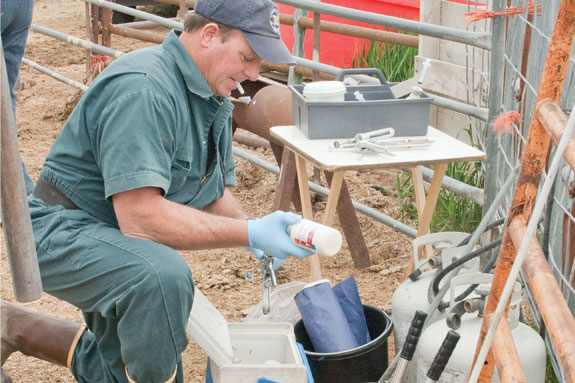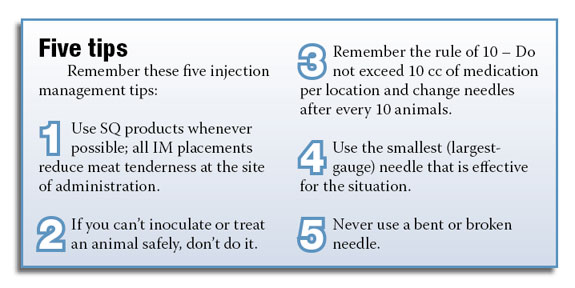Consumers today are demanding the beef they purchase be wholesome and safe. They’re also interested in how you handle and raise your cattle.
So, as a producer, you need to find solutions to satisfy consumers, as well as remain profitable. In order to meet these justifiable demands, we all need to be diligent in assuring quality in our final beef products.
One way to assure consumer confidence in beef is to select proper medications as a part of our regular husbandry practices to improve health, control disease or increase productivity.
Recommended management procedures and proper husbandry techniques have been developed through the Beef Quality Assurance (BQA) program started by the National Cattlemen’s Beef Association (NCBA).
This nationally coordinated and state-implemented program provides systematic information to U.S. beef producers to make certain all beef consumers can have confidence in the entire beef industry.
Questions regarding these practices should be discussed with your veterinarian or extension agent.
Veterinarians and producers administer medications to cattle through the skin, using a needle and syringe for various reasons.
Vaccines are administered to prevent disease, while antibiotics are used to treat bacterial infections.
Use of a veterinary syringe and needle to direct the pharmaceutical or biological medication to a specific location in the animal may be the best, or the only, route of administration for a particular medication.
Vaccines and antibiotics commonly are placed directly into the muscle (intramuscularly or IM), just under the skin (subcutaneously or SQ) or directly into the bloodstream (intravenously or IV).
When you have a choice in the route of administration, your decision may be based on cost, ease of use, effectiveness, accuracy and reliability.
Decisions to use injectable medications in your cattle should be made after careful consideration.
The process of administering vaccines and antibiotics to cattle inherently carries certain risks to the animal, the operator and the consumer, so it is always best to seek the advice of your animal-health provider.
But used properly, these food production technologies improve animal health and food safety.
A proper treatment protocol is important to eliminate complications associated with the administration of medications.
Improper treatment methods could lead to the spread of diseases from cross-contamination, injuries or infection at the injection site due to dirty, bent, broken or dull needles.
Adequate restraint of cattle prior to treatment is necessary to reduce the risk of injury to both the animal and humans. Additionally, you always must be aware of the risk of inadvertently puncturing your own skin with the needle.
Another often overlooked concern is the financial loss related to carcass damage following an injection.
There also are production losses related to pre-harvest withholding times and missed opportunities for beef sales.
Of utmost concern to everyone in the beef food chain is the possibility of injection-site blemishes or product residues in the final beef product.
While there is inherent risk to any procedure used in the care of livestock, problems can be eliminated and results can be improved by understanding the key points in this veterinary care process.

Timing is critical
The decision of when to, or when not to, give medications should be based on medically sound principles. The expression that “timing is everything” is appropriate when it comes to cattle medications.
Always consider the effect of slaughter withholding times on marketing decisions before administering a medication.
Read the label
The route that medications are given by influences how well the product works and the fate of the active ingredients in the animal’s system.
That’s why the label on medications describes the appropriate routes of administration. Never deviate from the label recommendations without the advice of your veterinarian.
In fact, it is unlawful to administer any vaccine or antibiotic in any dosage or by any other means than is stated on the label unless directed to do so by your veterinarian.
Always seek the advice of your veterinarian whenever there is doubt about appropriateness of using a medication administered intramuscularly or subcutaneously.
SQ is best
Some products are labeled for either IM or SQ use. Use the SQ route of administration whenever you have that option to reduce the risk of an injection-site lesion within the carcass.
Intramuscular injections always should be given in the muscles of the neck to avoid blemishes in more valuable carcass cuts, regardless of the age of the animal.
All drug placements that target the muscle reduce the tenderness of the edible red meat at that location and, if not done properly, will leave an unappealing blemish.
Never administer vaccines or antibiotic medications in the muscles of the rear leg or over the rump. Subcutaneous injections always should be given in front of the shoulder.
Safety first
When administering veterinary care, animals should be properly restrained to avoid injury to either the animal or you.
This means the animal must be held well enough that you can safely approach the animal and inoculate or vaccinate without causing injury due to the restraint or the syringe system.
If you cannot give the medication safely, don’t give it.
Dosage instructions
The volume of medication given at an injection site depends on the dosage of the product, as well as the route of administration and the maximum volume recommended per location.
Always follow the label recommendations. In most situations, do not exceed 10 cc per location.
Needle size
Needles used to administer vaccines and antibiotics are available in various lengths and diameters. The diameter of a needle is measured by its gauge; the larger the gauge number, the smaller the diameter of the needle.
As a general rule, use the smallest diameter that is reasonable for the product type and volume to be administered.
Only use aluminum hub needles, because they are less likely to break. Never use or try to straighten a bent or broken needle in an attempt to salvage it for re-use.
Sanitation
Good sanitation practices are important when giving medications via intramuscular or subcutaneous methods. Plastic disposable syringes work best for giving treatment medications.
Syringes used for giving vaccines to large numbers of cattle should be washed after every use with very hot, soapy water and then rinsed well with hot water.
Never enter a medication bottle with a used needle; only use a new, clean needle to draw a medication or vaccine into your syringe to avoid contamination of the remaining product.
No more than 10 animals should be treated with the same needle to reduce the risk of blemishes and the spread of disease between animals.
The decision to administer veterinary medications via injection should be made only after comparing the benefits and the risks of doing so.

Your veterinarian is the best source of advice on maximizing the benefits of treatment and minimizing any problems.
When used correctly, medications improve animal health and well-being, increase profitability and provide consumers with a higher-quality food product. ![]()
John Mayer is a technical services veterinarian for Intervet Schering-Plough Animal Health.
PHOTO
TOP: Using the proper injection equipment for larger numbers of cattle protects the sanitation of your herd. Photo by Ray Merritt.
BOTTOM: Veterinarian Steve Dahlquist begins preparations for vaccinations on a herd in Idaho. Photo by Philip Warren.

John Mayer
Intervet Schering-Plough Animal Health
john.mayer2@sp.intervet.com







